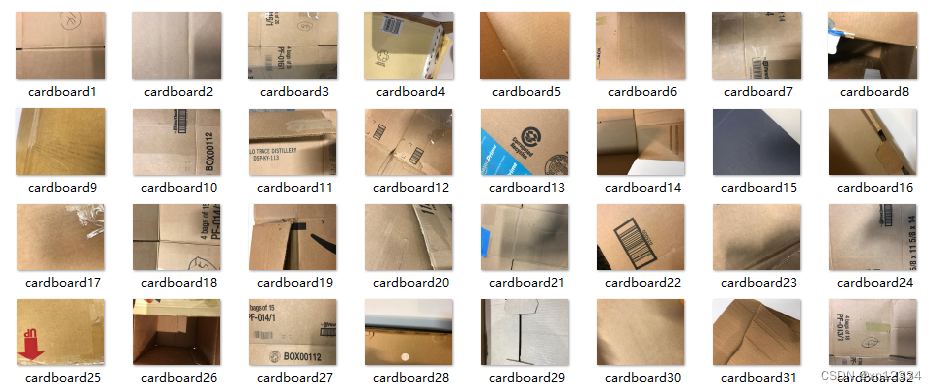【YOLO格式垃圾分类数据集秘籍】:构建高效垃圾分类模型的基石
发布时间: 2024-08-15 22:58:53 阅读量: 35 订阅数: 36 


# 1. YOLO格式垃圾分类数据集概览
YOLO(You Only Look Once)格式垃圾分类数据集是专门为训练和评估YOLO模型而设计的图像数据集。它包含大量标注良好的垃圾图像,这些图像被组织成一个统一的格式,以方便机器学习算法处理。
YOLO格式垃圾分类数据集通常包含以下信息:
* **图像:**代表不同类型垃圾的图像,如塑料、纸张、金属和玻璃。
* **标注:**每个图像中垃圾对象的边界框和类别标签。
* **元数据:**有关图像和标注的其他信息,例如图像大小、拍摄时间和地点。
# 2. YOLO格式垃圾分类数据集构建技巧
### 2.1 数据收集与预处理
#### 2.1.1 数据源的获取和筛选
**数据源获取:**
- 垃圾分类相关网站和数据库,如 Kaggle、ImageNet
- 垃圾分类比赛数据集,如 COCO、VOC
- 自行拍摄或收集垃圾图像
**数据筛选:**
- 过滤掉模糊、过暗或过亮、分辨率过低或过高的图像
- 删除重复、冗余或不相关的图像
- 根据垃圾类别进行分类和筛选
#### 2.1.2 数据的标注和整理
**数据标注:**
- 使用标注工具(如 LabelImg、CVAT)对垃圾图像进行标注
- 标注垃圾的边界框和类别标签
- 确保标注准确无误,避免误标和漏标
**数据整理:**
- 将标注信息导出为 YOLO 格式的标注文件(.txt)
- 标注文件包含图像文件名、边界框坐标、类别标签等信息
- 组织和管理标注文件,确保数据的一致性和可追溯性
### 2.2 数据增强与扩充
#### 2.2.1 数据增强方法
- **随机裁剪:**从图像中随机裁剪不同大小和宽高比的区域
- **随机旋转:**将图像随机旋转一定角度
- **随机翻转:**水平或垂直翻转图像
- **颜色抖动:**调整图像的亮度、对比度、饱和度和色相
- **添加噪声:**在图像中添加高斯噪声或椒盐噪声
#### 2.2.2 数据扩充策略
**过采样:**增加少数类垃圾图像的数量,以平衡数据集
**欠采样:**减少多数类垃圾图像的数量,以提高模型对少数类的识别能力
**合成数据:**使用生成对抗网络(GAN)或其他方法生成新的垃圾图像,以扩充数据集
**代码示例:**
```python
import cv2
import numpy as np
# 随机裁剪
def random_crop(image, size):
height, width, _ = image.shape
x = np.random.randint(0, width - size[0])
y = np.random.randint(0, height - size[1])
return image[y:y+size[1], x:x+size[0]]
# 随机旋转
def random_rotate(image, angle):
return cv2.rotate(image, cv2.ROTATE_90_CLOCKWISE)
# 随机翻转
def random_flip(image):
return cv2.flip(image, 1)
# 颜色抖动
def color_jitter(image):
brightness = np.random.uniform(0.5, 1.5)
contrast = np.random.uniform(0.5, 1.5)
saturation = np.random.uniform(0.5, 1.5)
hue = np.random.uniform(-0.5, 0.5)
return cv2.cvtColor(image, cv2.COLOR_BGR2HSV)
```
# 3. YOLO格式垃圾分类数据集实践应用
### 3.1 YOLO模型的训练和评估
#### 3.1.1 模型的配置和训练
1. **模型配置:**
- 选择合适的YOLO模型架构,如YOLOv5或YOLOv4。
- 确定输入图像大小、训练批次大小和学习率。
- 设置训练迭代次数和保存权重文件的间隔。
2. **训练过程:**
- 将数据集划分为训练集和验证集。
- 使用数据加载器加载训练数据并进行预处理。
- 构建YOLO模型并初始化权重。
- 采用梯度下降算法优化模型参数。
- 监控训练损失和验证精度,并在必要时调整训练超参数。
#### 3.1.2 模型的评估和调优
1. **模型评估:**
- 使用验证集评估训练模型的性能。
- 计算平均精度(mAP)、召回率和F1分数等指标。
- 分析混淆矩阵以识别模型的错误类型。
2. **模型调优:**
- 调整训练超参数,如学习率、批次大小和正则化参数。
- 尝试不同的数据增强技术以提高模型泛化能力。
- 探索不同的模型架构或特征提取器以提升模型性能。
### 3.2 垃圾分类模型的部署和使用
#### 3.2.1 模型的部署环境
1. **硬件选择:**
- 选择具有足够计算能力的GPU或CPU。
- 考虑模型大小和推理速度要求。
2. **软件环境:**
- 安装必要的深度学习框架(如PyTorch或TensorFlow)。
- 准备模型推理脚本和依赖库。
#### 3.2.2 模型的推理和应用
1. **推理过程:**
- 加载训练好的YOLO模型。
- 预处理输入图像,如调整大小和归一化。
- 执行前向传播以预测边界框和类别。
- 后处理预测结果,如筛选低置信度的边界框。
2. **应用场景:**
- 实时垃圾分类:将模型部署到移动设备或嵌入式系统中,用于现场垃圾分类。
- 图像分析:集成模型到图像处理管道中,用于垃圾图像分类和标记。
- 数据分析:使用模型分析垃圾分类数据,识别趋势和模式。
# 4. YOLO格式垃圾分类数据集进阶应用
### 4.1 垃圾分类模型的优化与提升
#### 4.1.1 模型架构的改进
- **深度卷积神经网络(DCNN)**:使用更深的卷积层结构,增加网络的特征提取能力。
- **残差网络(ResNet)**:引入残差连接,缓解梯度消失问题,提高模型的训练稳定性和准确性。
- **注意力机制**:加入注意力模块,增强模型对关键特征的关注,提高分类精度。
#### 4.1.2 训练策略的优化
- **数据增强**:采用更丰富的增强策略,如随机裁剪、翻转、色彩抖动等,提高模型的泛化能力。
- **梯度下降算法**:使用优化算法,如Adam、RMSProp,加快模型的收敛速度。
- **学习率衰减**:随着训练的进行,逐步降低学习率,提高模型的稳定性。
### 4.2 垃圾分类模型的扩展与创新
#### 4.2.1 多任务学习
- **联合训练**:将垃圾分类任务与其他相关任务(如目标检测、语义分割)联合训练,共享特征提取器,提高模型的整体性能。
- **知识蒸馏**:将训练好的垃圾分类模型作为教师模型,指导学生模型学习,提升学生模型的分类精度。
#### 4.2.2 弱监督学习
- **伪标签**:利用未标注数据生成伪标签,辅助模型训练,缓解标注成本。
- **自训练**:模型利用自己的预测结果生成伪标签,不断更新训练数据,提升模型的性能。
### 代码示例
**模型架构改进:ResNet**
```python
import torch
import torch.nn as nn
class ResNetBlock(nn.Module):
def __init__(self, in_channels, out_channels, stride=1):
super(ResNetBlock, self).__init__()
self.conv1 = nn.Conv2d(in_channels, out_channels, kernel_size=3, stride=stride, padding=1)
self.bn1 = nn.BatchNorm2d(out_channels)
self.relu1 = nn.ReLU()
self.conv2 = nn.Conv2d(out_channels, out_channels, kernel_size=3, stride=1, padding=1)
self.bn2 = nn.BatchNorm2d(out_channels)
self.shortcut = nn.Sequential()
if stride != 1 or in_channels != out_channels:
self.shortcut = nn.Sequential(
nn.Conv2d(in_channels, out_channels, kernel_size=1, stride=stride),
nn.BatchNorm2d(out_channels)
)
def forward(self, x):
out = self.conv1(x)
out = self.bn1(out)
out = self.relu1(out)
out = self.conv2(out)
out = self.bn2(out)
out += self.shortcut(x)
out = self.relu2(out)
return out
```
**训练策略优化:学习率衰减**
```python
import torch.optim as optim
optimizer = optim.Adam(model.parameters(), lr=0.001)
for epoch in range(num_epochs):
# ...
# 学习率衰减
lr = 0.001 * (0.95 ** epoch)
for param_group in optimizer.param_groups:
param_group['lr'] = lr
```
### 逻辑分析
**模型架构改进:ResNet**
ResNet通过残差连接,将输入数据直接传递到输出,缓解了梯度消失问题。残差连接允许网络学习残差特征,而不是整个特征映射,从而提高了训练稳定性和准确性。
**训练策略优化:学习率衰减**
随着训练的进行,学习率逐渐降低,使模型能够更精细地调整权重。较高的学习率在训练初期有助于快速收敛,而较低的学习率在后期有助于提高模型的稳定性和泛化能力。
# 5. YOLO格式垃圾分类数据集未来展望
随着人工智能技术的发展,YOLO格式垃圾分类数据集在未来具有广阔的应用前景。以下是一些值得关注的发展方向:
- **模型轻量化:**开发轻量级的YOLO模型,以满足移动设备和嵌入式系统的部署需求。
- **实时推理:**优化YOLO模型的推理速度,实现实时垃圾分类,满足快速响应的需求。
- **跨领域应用:**探索YOLO格式垃圾分类数据集在其他领域的应用,例如医疗影像分析和工业缺陷检测。
- **多模态融合:**结合图像、文本和传感器数据等多模态信息,提升垃圾分类模型的鲁棒性和准确性。
- **自动化数据标注:**利用人工智能技术,实现垃圾分类数据集的自动化标注,提高数据处理效率和质量。
- **联邦学习:**通过联邦学习技术,在多个设备或机构之间协作训练垃圾分类模型,保护数据隐私并提升模型性能。
- **可解释性:**增强YOLO模型的可解释性,了解模型的决策过程,提高用户对模型的信任度。
- **绿色计算:**探索绿色计算技术,优化YOLO模型的训练和推理过程,减少碳足迹。
0
0





